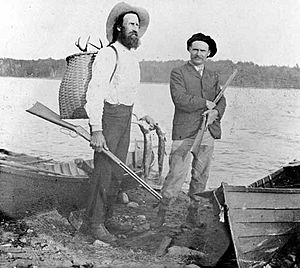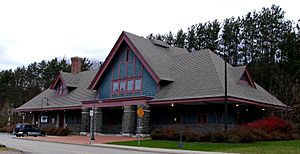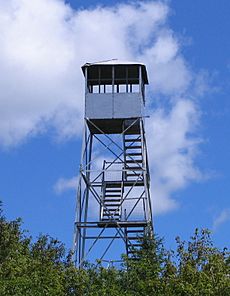Adirondack Park facts for kids
Quick facts for kids Adirondack Park |
|
|---|---|
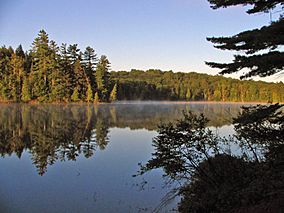
Long Pond, in the Saint Regis Canoe Area.
|
|
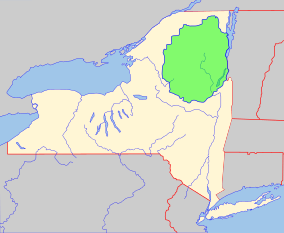
Park area highlighted in green, bounded by the Blue Line, within New York state
|
|
| Location | New York, United States |
| Area | 9,375 sq mi (24,280 km2) |
| Established | New York State Forest Preserve |
| Named for | Mohawk for tree eaters. |
| Operator | Adirondack Park Agency, New York State Department of Environmental Conservation |
|
Adirondack Forest Preserve
|
|
| Area | 2,000,000 acres (8,100 km2) |
| NRHP reference No. | 66000891 |
| Significant dates | |
| Added to NRHP | October 15, 1966 |
| Designated NHL | May 23, 1963 |
The Adirondack Park is a special part of New York's Forest Preserve. It is located in northeastern New York, United States. The park was created in 1892. Its main goals were to offer a place for people to enjoy nature and to protect important water sources.
The park's border generally follows the Adirondack Mountains. Unlike most parks, about half of the land inside is privately owned. These private lands are called inholdings. The state lands within the park are known as the Forest Preserve. The Adirondack Park Agency helps manage how land is used, both public and private. This huge area includes 102 towns and villages. It also has farms, businesses, and a busy timber industry. About 132,000 people live here all year, plus 200,000 seasonal visitors. Having human communities inside makes this park a unique example of conservation. The Forest Preserve was named a National Historic Landmark in 1963.
The park covers over 6.1 million acres (about 2.5 million hectares). It has more than 10,000 lakes and 30,000 miles (48,000 km) of rivers and streams. You can find many different natural areas here. These include wetlands and about 200,000 acres (81,000 hectares) of very old forests.
History of Adirondack Park
To learn about the area before the park was formed, see History of the Adirondack Mountains.
Early Tourism in the Adirondacks
Before the 1800s, people thought the wilderness was a scary and empty place. But as Romanticism grew in the United States, views changed. Writers like James Fenimore Cooper and Henry David Thoreau helped people see nature as beautiful.
In 1849, Joel Tyler Headley wrote a book called Adirondack; or, Life in the Woods. This book made people interested in the area. Soon, hotels and stagecoach lines started to appear. In 1869, William Henry Harrison Murray wrote a guide that showed the Adirondacks as a fun place to relax.
A rich businessman named Thomas Clark Durant bought a lot of land in the central Adirondacks. He built a railroad from Saratoga Springs to North Creek. By 1875, there were over 200 hotels in the Adirondacks. Famous ones included Paul Smith's Hotel. Around this time, large, fancy vacation homes called Great Camps were also built.
Protecting New York's Water Supply
After the Civil War, the economy grew quickly. This led to a lot of logging and cutting down of trees. This was especially true in the southern Adirondacks.
In 1870, Verplanck Colvin climbed Seward Mountain. He saw how much damage lumberjacks had caused. He wrote a report about it. In 1872, he became the Superintendent of the Adirondack Survey. He was given money to study the Adirondacks.
In 1873, Colvin wrote another report. He warned that if the Adirondack watershed got worse, it would harm the Erie Canal. The Erie Canal was very important for New York's economy back then. He suggested creating a state forest preserve for the whole Adirondack region.
Article XIV: Forever Wild Protection
In 1884, a state group led by botanist Charles Sprague Sargent suggested creating a forest preserve. They wanted it to be "forever kept as wild forest lands." The New York State Legislature then passed a law in 1885. This law said that all state lands in certain counties in the Adirondacks and Catskills would be Forest Preserve. They would be kept as wild forest lands forever. This law also created a Forest Commission to take care of the Forest Preserve.
In 1894, a very important part was added to the New York State Constitution. It is now called Article XIV, Section 1. It says:
The lands of the state, now owned or hereafter acquired, constituting the forest preserve as now fixed by law, shall be forever kept as wild forest lands. They shall not be leased, sold or exchanged, or be taken by any corporation, public or private, nor shall the timber thereon be sold, removed or destroyed.
This means the state lands in the park must always stay wild. They cannot be sold or used for logging.
In 1902, a law officially defined the Adirondack Park. It listed the counties and towns within it. In 1912, the law made it clear that the park included both public and private lands. These rules have stopped many attempts to develop or cut timber in the park. The strong protections here helped create the U.S. National Wilderness Act of 1964. Because of these laws, many parts of the Adirondack forest have never been logged. They are old-growth forests.
20th-Century Development and Growth
In the early 1900s, more and more people started visiting the park for fun. The State Conservation Department (now called the DEC) built more places for visitors. These included boat docks, tent areas, and lean-tos. When Interstate 87 was built in the 1960s, private lands faced a lot of pressure for development.
This led to the creation of the Adirondack Park Agency (APA) in 1971. The APA's job was to make plans for how land could be used. This included both public and private lands within the Blue Line.
The APA worked with the DEC to create the State Land Master Plan. This plan became law in 1973. It aims to guide new buildings and growth towards existing communities. These areas already have roads, power, and services.
In 2008, The Nature Conservancy bought Follensby Pond. This was about 14,600 acres (5,900 hectares) of private land inside the park. They plan to sell it to the state. It will then become part of the Forest Preserve.
Adirondack Park: 1900 vs. 2000
This table shows how the Adirondack Park changed over 100 years.
| Year: | 1900 | 2000 |
|---|---|---|
| Area of the Park | 2,800,000 acres (1,100,000 ha) | 5,820,313 acres (2,355,397 ha) |
| State-owned area | 1,200,000 acres (490,000 ha) (43%) | 2,595,859 acres (1,050,507 ha) (44.6%) |
| Travel time, New York City to Old Forge | 6.5 hours by railroad | 5 hours by car |
| Permanent park residents | 100,000 | 130,000 |
| Length of public road in the park | 4,154 miles (6,685 km) plus 500 miles (800 km) of passenger railroad track | 6,970 miles (11,220 km) |
| Industry | 92 sawmills, 15 iron mines, 10 pulp/paper mills | 40 sawmills, 1 pulp/paper mill |
This information was put together by the Adirondack Experience in Blue Mountain Lake, New York.
How Adirondack Park is Managed
The park is managed by two main groups. These are the New York State Department of Environmental Conservation (DEC) and the Adirondack Park Agency (APA). This is different from other state parks in New York. Those are managed by the Office of Parks, Recreation and Historic Preservation. The State Land Master Plan helps classify state lands.
The Adirondack Park Land Use and Development Plan (APLUDP) guides how private land is used. It helps direct building and development. The goal is to keep the park's natural beauty.
Land Use Classifications in the Park
About 49% of the park is privately owned. About 45% is state-owned land. The remaining 6% is water.
Private Land Use Areas
- Resource Management: This is 51% of private land. It's used for homes, farming, and forestry. Most building here needs a special permit. There's a limit of about 15 buildings per square mile.
- Rural Use: This is 17% of private land. Many uses are allowed. Homes and less intense development are best here. It helps keep the rural feel. There's a limit of about 75 buildings per square mile.
- Low Intensity: This is 9% of private land. Most uses are allowed. Homes are common here, but not as many as in towns. There's a limit of about 200 buildings per square mile.
- Moderate Intensity: This is 3% of private land. Most uses are allowed. Homes are very common here. There's a limit of about 500 buildings per square mile.
- Hamlet: This is 2% of private land. These are the main towns and service areas. The APA encourages building here. Few permits are needed. This includes very tall buildings, large projects, or those near wetlands. There is no limit on buildings per square mile.
- Industrial: This is less than 1% of private land. These are areas where factories or businesses are, or could be. There is no limit on buildings per square mile.
Adirondack Park State Land Use Areas
- Wild Forest: This is 51% of state land. These areas have seen more human activity. They can handle more visitors and activities. Often, these lands were heavily logged before the state bought them. Vehicles with motors are allowed here.
- Wilderness: This is 46% of state land. These areas are mostly untouched by humans. They are managed like federal U.S. Wilderness Areas. No motor vehicles are allowed. Activities are quiet ones like hiking, camping, hunting, birding, and angling. These activities have rules to make sure you leave no trace.
- Canoe Area: This is less than 1% of state land. These areas are like wilderness but have many streams, lakes, and ponds. This makes them great for water-based fun. The Saint Regis Canoe Area is the only one in the park.
- Primitive: This is less than 1% of state land. These areas are like wilderness. But they might have old buildings that are hard to remove. For most visitors, there's no real difference between primitive and wilderness areas.
- Intensive Use: This is less than 1% of state land. These are places like state campgrounds or day-use areas. The Whiteface Mountain ski area is in this group.
- Historic: This is less than 1% of state land. These are state-owned buildings or sites. They are important to the history, architecture, or culture of the Adirondacks. Many are on the National Register of Historic Places.
- State Administrative: This is less than 1% of state land. These are DEC-owned lands used for things other than the Forest Preserve. This includes research centers and fish hatcheries.
Groups Protecting the Park
Many private groups help protect the Adirondack Park. They sometimes buy land to sell back to New York State. This adds to the public part of the park. Here are some of these groups:
- The Adirondack Council: Started in 1975, this is New York's largest environmental group. They work to keep the park's wild nature and healthy environment. They do research, teach people, and work with lawmakers.
- Adirondack Wild: This group works to protect the "forever wild" rule (Article 14) of the New York Constitution.
- The Wildlife Conservation Society's Adirondack Program
- The Adirondack Chapter of the Nature Conservancy
- The Adirondack Mountain Club: With 28,000 members, this group also works to protect the park's lands.
- Protect the Adirondacks!: Founded in 1901 as the Association for the Protection of the Adirondacks (AFPA). It works to protect the park's natural and human communities.
- The Adirondack Research Consortium (ARC): This group brings together scientists and people who work to improve the park.
Conservation Efforts
The fur trade almost made the beaver disappear by 1893. Other animals like moose, wolves, and cougars were hunted. They were hunted for food, sport, or because they were seen as a threat to farm animals.
Efforts to bring beavers back started around 1904. The remaining beavers were combined with those from Canada and later from Yellowstone. The beaver population quickly grew. It reached about 2,000 in ten years and 20,000 by 1921. This was a success, but too many beavers caused problems for waterways and timber.
People also tried to bring elk back to the Adirondacks. It's not clear if elk ever lived here before. After two tries, over 150 elk were released in 1903 and survived. The elk population grew for a few years but then dropped due to poaching.
To protect elk, the DeBar Mountain Game Refuge was created. This was mainly for hunting, not just for nature. The refuge had a fence and caretakers. The Civilian Conservation Corps (CCC) also worked in the park. They built roads and expanded water supplies.
However, the CCC also trapped and killed "vermin." These were animals like hawks, owls, and foxes that hunted other animals. This caused problems. For example, the deer population grew too large by 1945.
Today, there are ongoing efforts to bring back native animals that were lost. These include the raccoon, moose, black bear, coyote, opossum, beaver, porcupine, fisher, marten, river otter, bobcat, and Canadian lynx. Not all of these efforts have worked yet. There are 53 known types of mammals living in the park.
Many interesting birds of prey live and breed here. These include the red-tailed hawk, broad-winged hawk, peregrine falcon, osprey, and different types of owls. Other special birds found here are the Canada jay and black-backed woodpecker.
The park has over 3,000 lakes and 30,000 miles (48,000 km) of streams and rivers. Many areas are wild with no towns or roads nearby. The park has over 2,000 miles (3,200 km) of hiking trails. This is the largest trail system in the country.
Tourism and Fun Activities
About 7 to 10 million tourists visit the park each year. There are many places to stay. These include cabins, lodges, and hotels. Popular spots are around Lake Placid, Lake George, Saranac Lake, and Old Forge. Even though winters can be very cold, the fresh air helped people with tuberculosis in the early 1900s.
The park has several golf courses. These include the Ausable Club and the Lake Placid Club. Many Adirondack Mountains have ski areas. Some popular ones are Whiteface Mountain, Gore Mountain, and Mount Morris.
You can go hunting and fishing in the Adirondack Park. There are strict rules to protect the animals. Because of these rules, the lakes and rivers have many large trout and black bass. Snowmobiles are allowed on a large network of trails in some parts of the park.
Cultural Attractions
The Adirondack Park Agency visitor interpretive centers help visitors learn about the park. They offer educational programs, exhibits, and nature trails. These programs are for both school groups and the public.
The Wild Center in Tupper Lake has many exhibits about the region's natural history. It has a 1,000-foot (300 m) long series of elevated bridges that go over the forest. Many exhibits feature live animals like turtles, otters, birds, fish, and porcupines. The center is open all year.
The Adirondack Experience in Blue Mountain Lake has a large collection about human life in the park.
The Six Nation Indian Museum in Franklin teaches about Iroquois (Haudenosaunee) culture. It focuses on their ideas about nature. It uses artifacts and presentations to share traditional values.
Hiking and Rock Climbing Adventures
The 46 highest mountains in the Adirondack High Peaks were once thought to be over 4,000 feet (1,200 m) tall. Brothers Robert and George Marshall climbed them between 1918 and 1924. Later surveys showed that four of these peaks are just under 4,000 feet. Some hikers try to climb all 46 original peaks. There is a Forty Sixers club for those who do. Twenty of these 46 mountains still do not have official trails.
You can find cliffs for rock climbing and ice climbing all over the park.
Watersports Fun
Many lakes in the park are high up, over 1,500 feet (460 m) above sea level. Their shores are often rocky and wild. This beautiful scenery makes them very popular for tourists. The park is home to the Adirondack Canoe Classic.
Flatwater and whitewater canoeing and kayaking are very popular. Hundreds of lakes, ponds, and slow-moving streams connect. This creates routes from less than 1 mile (1.6 km) to week-long trips. Whitewater kayaking and canoeing are popular on many rivers, especially in spring. Whitewater rafting trips happen in spring on the Moose River near Old Forge. Raft trips are also possible on the Hudson River from April to October.
Motorboating is only restricted on a few bodies of water.
Development and Businesses
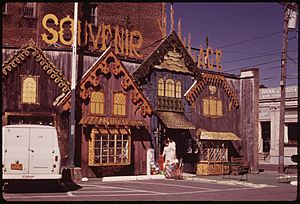
While the park has large wild areas, some parts are developed.
Towns with more than 5,000 people include:
- Tupper Lake
- Ticonderoga
- Dannemora, which has the Clinton Correctional Facility.
- Harrietstown, which includes Saranac Lake and the Adirondack Regional Airport.
- North Elba, which includes Lake Placid and the Lake Placid Olympic Sports Complex.
Interstate 87, also called the Northway, was finished in the 1970s. It runs north to south through the eastern part of the park. It connects Montreal to Upstate New York. The park also has military training routes for the Air National Guard.
There are several business parks in Essex and Franklin Counties. Many maple syrup producers work here. Their work is shown at the American Maple Museum in Croghan.
Educational places include the State University of New York College of Environmental Science and Forestry and Paul Smith's College.
Railways in the Adirondacks
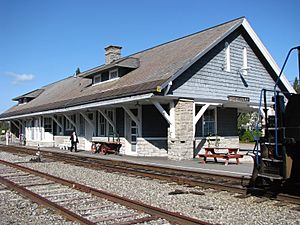
Railways were used a lot from about 1871 to the 1930s. They carried both people and goods. Stagecoaches also helped with travel. Many different rail companies operated here. Some were the Chateauguay Railroad and the New York Central Railroad.
The main rail company for the big resorts was the New York Central Railroad. Its Adirondack Division went to places like Loon Lake, Saranac Lake, and Lake Placid. In 1920, there were 10 train stops in Big Moose.
Starting in the 1930s, people began using cars more than trains. Passenger train service ended in 1965. Freight service also decreased after World War II.
Airports in the Park
There are many small airstrips and lakes for seaplanes. But there is only one commercial airport inside the park. The Adirondack Regional Airport is near Saranac Lake. Its commercial flights get government funding to help small communities. Plattsburgh International Airport is located 10 miles (16 km) outside the park.
Architectural Heritage
The Adirondacks have a special building style. It's called the Adirondack architectural style. This style is seen in the rugged Great Camps. Builders used local materials. They placed buildings to fit naturally into the wooded landscape. These camps for rich people looked rustic but were very comfortable inside.
Fire Towers
In 1903 and 1908, large fires burned almost 1 million acres (400,000 hectares) of forest. In 1909, the first Adirondack fire lookout tower was built on Mount Morris. It was made of logs. Many more were built over the next few years. From 1916, steel towers were built. At one time, there were fire towers at 57 places in the park. The system worked for about 60 years. Now, other technologies are used. Today, 34 towers remain. Many have been fixed up and are open to the public. Some are on the National Register of Historic Places.
Industrial Buildings
- McIntyre Furnace & McNaughton Cottage: This includes an 1853 blast furnace and the 1832 McNaughton Cottage. It also has remains of the Tahawus Club buildings and old mining sites.
Churches
- St. Regis Presbyterian church: This church was designed by architect William L. Coulter. It was built on land given by Paul Smith. Money came from donations, mostly from summer residents. It was a church from 1899 to 2010.
Bridges and Infrastructure
- The Bow Bridge: This bridge in Hadley is one of only two special "parabolic" bridges in the region. It's one of about 50 left in the country. It was built over the Sacandaga River in 1885.
- Jay Covered Bridge: This is a covered bridge over the Ausable River.
- The AuSable Chasm Bridge.
Homes and Leisure Spots
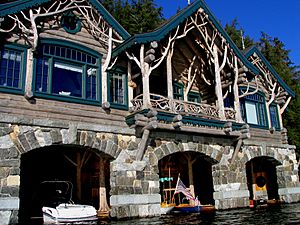
- The Adirondack lean-to: This is a simple, three-sided log shelter.
- Saranac Village at Will Rogers: This retirement community was built in 1930. It was a place for vaudeville performers to get treatment for tuberculosis. It closed in 1975. In 1998, it was bought and reopened in 2000 as a retirement community.
- Camp Santanoni: This was once a private estate of about 13,000 acres (53 km²). Now it belongs to the state, in Newcomb. It had about 45 buildings. It is now a National Historic Landmark. It is one of the earliest and grandest of the Great Camps of the Adirondacks.
- Wellscroft: Located in Upper Jay, this is a large summer home. It has a Tudor Revival style. The first floor is made of local fieldstone. The inside has many Arts and Crafts features. Other buildings on the property include a power house and a gazebo. It was added to the National Register of Historic Places in 2004.
- Prospect Point Camp: This is a Great Camp known for its unique chalets. They were inspired by European hunting lodges.
See Also
- Adirondacks
- Protected areas of New York
- National Register of Historic Places
- Hudson River
Images for kids
-
View of Dix Mountain Wilderness Area from the summit of Giant Mountain.
-
View from Long Pond Mountain of the St. Regis Canoe Area (High Peaks in the background)


